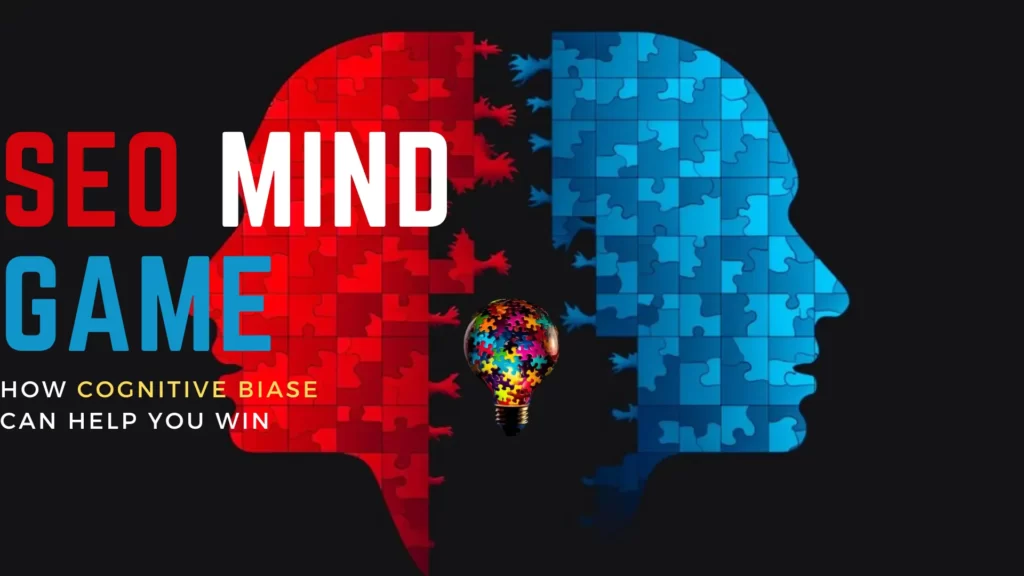The SEO Mind Game: How Cognitive Biases Can Help You Win
Overview of Cognitive Biases Cognitive Bias Definition and Explanation Cognitive biases are thought patterns that can unintentionally impact how individuals perceive things and make decisions. Human cognition is naturally biased, which significantly affects user behavior and SEO. Knowing about cognitive biases is crucial for SEO and user behavior. In today’s digital era, comprehending cognitive biases, or mastering the SEO Mind Game, is vital due to high stakes and fierce competition. Developing winning strategies that appeal to the target market and boost conversion rates can be assisted by understanding cognitive biases, essentially helping you win the SEO Mind Game. This blog post examines cognitive biases’ influence on user behavior and SEO. Cognitive Discrimination and User Behavior A Brief on Cognitive Biases That Affect User Decision-Making Cognitive biases significantly affect how users behave. The most common cognitive biases include anchoring, availability, and confirmation biases. Cognitive biases like Loss Aversion can impact user behavior. Here’s an illustration of this phenomenon. The cognitive bias called loss aversion occurs when individuals experience more pain from losing something than pleasure from gaining an equally valuable item. This bias influences decision-making in different situations. The impact of this bias is significant for user behavior, particularly when they anticipate losing out in cases such as pricing and promotions. The Details Behind How Cognitive Biases Can Influence User Behavior to Be Irrational Users’ perceptions, judgments, and decision-making are subject to the influence of cognitive biases causing irrational behavior. Making poor decisions that do not match one’s preferences or interests is shared among users. Decisions that are impacted by cognitive biases result in this happening. Improving website optimization and user experience depends on understanding these biases. Creating a captivating user experience requires businesses and marketers to factor in the biases of their users. They can develop more efficient and inclusive products and services by being aware. Making websites more user-friendly and producing compelling content for the desired audience is possible when businesses understand how cognitive biases shape user behavior. SEO Cognitive Biases Understanding How Cognitive Biases Impact Search Engine Optimization Cognitive biases greatly influence SEO. The behavior of users during information searches, interpretation of search results, and interaction with website content are governed by cognitive biases. This detail explains how cognitive biases, particularly the Framing Effect, can impact SEO tactics. Information presentation impacts people’s choices; this bias is known as the framing effect. SEO experts know that framing is critical to optimizing user engagement and actions on websites and search results. User Engagement with Search Results and Website Rankings: The Role of Cognitive Biases Perceptions of the relevance, legitimacy, and appeal of search results and website rankings are impacted by cognitive biases, which can ultimately lead to decreased user engagement. Reduced website traffic and revenue are possible outcomes of this situation. Enterprises aware of how cognitive biases affect user engagement can craft optimized content that appeals to their ideal customer. Considering cognitive biases when developing SEO strategies and content is crucial. Considering cognitive biases is crucial in both SEO strategies and content creation to ensure user engagement and compelling content. By acknowledging how cognitive biases impact user engagement, businesses can create better content for search and improve overall user behavior. Accessibility Preferences and User Behavior Understanding How the Availability Bias Impacts Decision-Making The tendency to base one’s judgments and choices on easily accessible and memorable information can lead to availability bias. In cases of rapid decision-making scenarios like online shopping or e-commerce, this bias notably influences user behavior. How the Availability Bias Shapes Users’ Attitudes and Decisions Individuals’ views and determinations may be influenced by availability bias as they typically lean more toward memory than factual information. If supporting the conclusions requires more accurate or complete data, this bias can cause false perceptions and judgments. Especially impactful is the availability bias on user engagement and conversion rates Availability bias can impact user engagement and conversion rates by shaping their perception of relevance and credibility. Perceived irrelevance or bias of information can deter users from engaging or converting. Minimize availability bias through website design and marketing strategies. Objective, pertinent content that caters to users’ interests and preferences is vital in mitigating the adverse effects of availability bias in website design and marketing. To combat bias’s adverse effects while boosting user interaction, companies should offer reliable, complete data to their consumers. SEO and confirmation bias learn how confirmation bias influences information processing. Confirmation bias can cause individuals to selectively search for, read, and recall information that aligns with their established opinions. SEO and user search behavior are greatly affected by this bias. A Comprehensive Examination of How Confirmation Bias Affects User Search Queries and Website Authenticity Search query patterns and website reliability can be affected by confirmation bias due to its influence on users’ perceptions of relevance and credibility. Even if the information is not entirely accurate or objective, users rely on information reinforcing their pre-existing beliefs and attitudes during research. Confirmation Bias: Its Effects on SEO Techniques and Content Optimization Confirmation bias can impact SEO strategies and content optimization by influencing user search preferences and behavior. To boost visibility, engagement, and conversions, businesses should aim to produce content that matches the tastes and beliefs of their audience. Ways to Combat Confirmation Bias in SEO to Elevate User Engagement and Trust Addressing confirmation bias in SEO requires producing information that resonates with users’ interests and preferences and remains unbiased and accurate. Creating compelling content while addressing user biases can help businesses boost their SEO performance and earn users’ trust. Optimization of Conversions and Anchoring Bias How Anchoring Bias Influences Decision-Making: An Overview Decisions made heavily reliant on the initial information are examples of anchoring bias. How users gauge value and price may be significantly influenced by this partiality. This could affect their purchasing decision and conversion rates. How Anchoring Bias Shapes User Perception of Prices and Value The anchoring bias impacts how users view prices and value by creating a reference point that consumers depend on when purchasing. Consumers’




